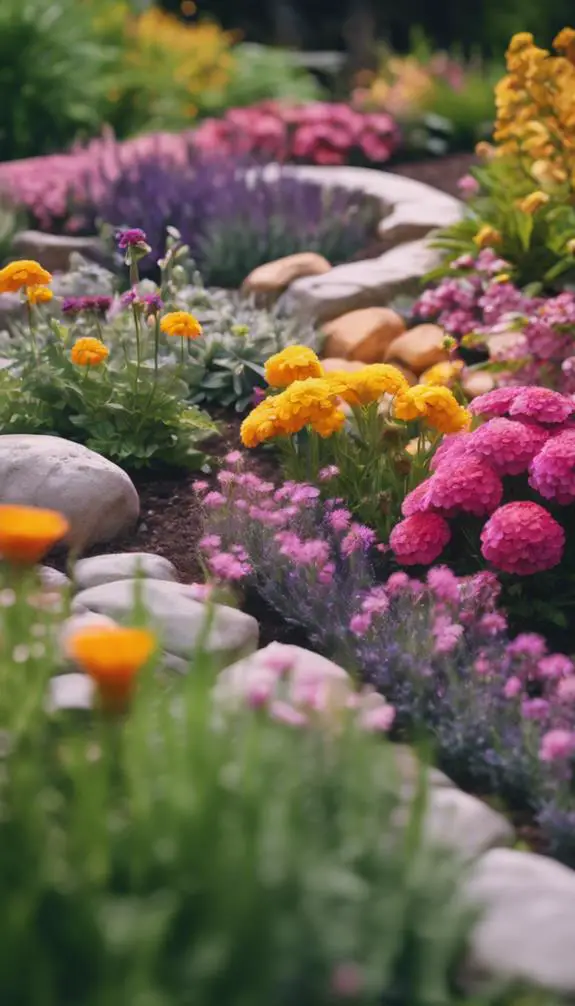As you start planning your vegetable garden, you're likely enthusiastic to get your hands dirty and start growing. But before you begin, take a step back and consider the bigger picture. A well-designed garden is more than just a collection of vegetables – it's a carefully crafted system that takes into account factors like sunlight, soil, and water. By evaluating your garden site, choosing the right location, and selecting the perfect vegetables, you'll set yourself up for success. But that's just the beginning – there are many more elements to explore, and the right design can make all the difference in the world.
Assessing Your Garden Site

Before designing your vegetable garden, you need to thoroughly assess your garden site, taking into account the amount of sunlight it receives daily, as well as the soil type, wind direction, and existing features that might impact your garden's layout and productivity.
This vital step is often overlooked, but it's essential for creating a thriving and efficient garden.
Conduct a garden survey to identify the site's strengths and weaknesses.
Observe the sun's movement across your garden, noting the areas that receive full sun, partial shade, or full shade.
Take soil samples to determine the pH level, nutrient content, and drainage.
Analyze the wind direction to identify potential areas of erosion or damage.
Identify existing features such as slopes, water sources, and obstacles that may impact your garden's design.
A thorough site analysis will help you create a tailored design that maximizes your garden's potential, ensuring a bountiful harvest and minimizing maintenance.
Choosing the Right Location
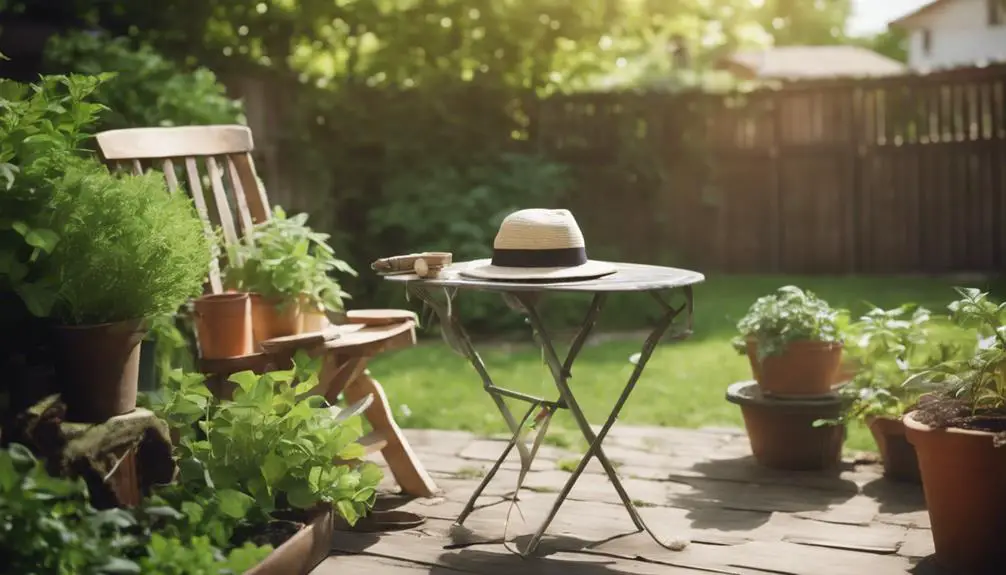
Select a location that receives at least six hours of direct sunlight a day, as most vegetables require ample sunlight to produce a bountiful harvest.
When choosing the right location, consider the garden orientation and how it affects sunlight exposure. A south-facing garden typically receives the most sunlight, while an east- or west-facing garden receives gentler morning or afternoon sun.
Avoid areas with shade from nearby trees, buildings, or yard features like pergolas or gazebos.
Take note of the yard's topography and how it affects drainage. A slight slope can improve drainage, but a steep slope may require terracing or raised beds.
Consider the proximity to water sources, tool sheds, and compost bins to minimize walking distances and improve efficiency.
Also, think about the accessibility of the location, especially if you plan to garden frequently or have mobility issues.
Understanding Sunlight Requirements
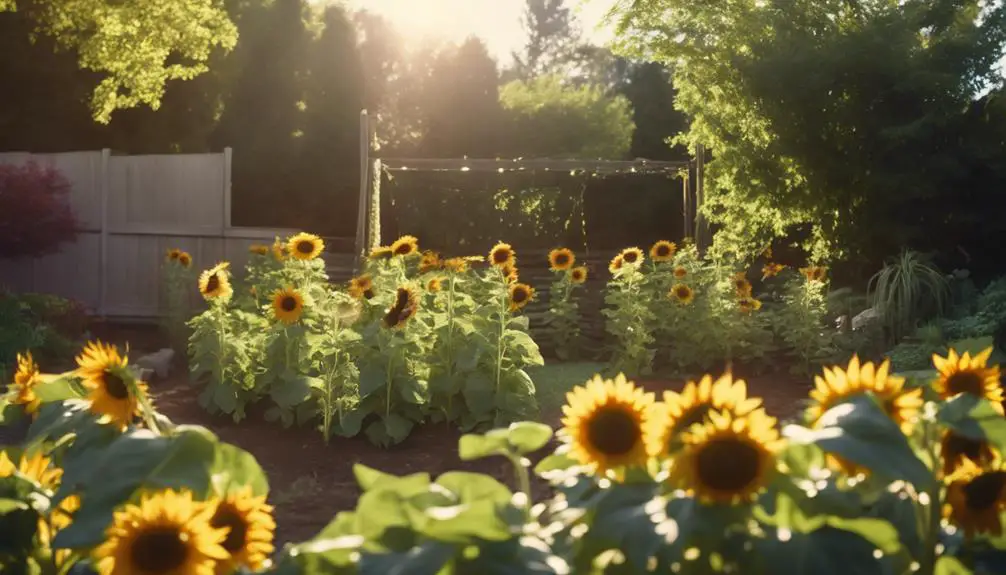
By understanding the specific sunlight requirements for each vegetable variety, you can strategically position them to receive the ideal amount of direct sunlight, partial shade, or dappled light they need to thrive.
Most vegetables require at least 6 hours of direct sunlight per day, but some, like lettuce and spinach, can tolerate partial shade. Others, like tomatoes and peppers, need full sun (8-10 hours of direct sunlight) to produce well.
When evaluating your garden's sunlight hours, consider daily exposure patterns. Observe how the sun moves across your yard, noting areas that receive morning sun, afternoon sun, or dappled light filtered through trees.
Take into account any obstructions, such as buildings or fences, that may cast shade. By mapping your garden's sunlight patterns, you can create a layout that maximizes each vegetable's potential.
For example, you might place sun-loving vegetables like eggplants and okra in the south-facing areas that receive the most intense sunlight, while reserving shadier spots for leafy greens like kale and collard greens.
Soil Preparation and Testing
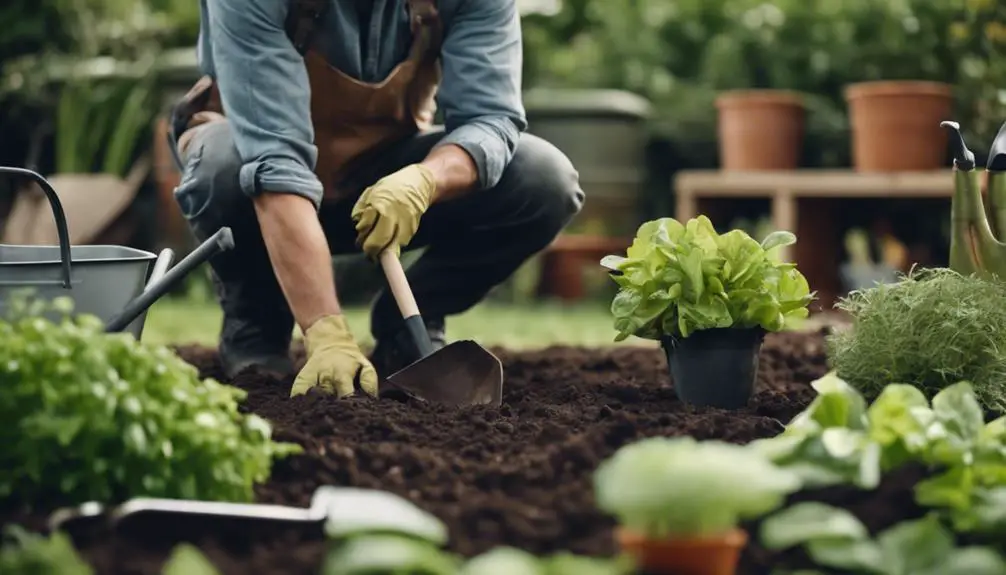
Test your soil type and pH levels to determine its nutrient composition and potential limitations, as this critical step will dictate the success of your vegetable garden.
You'll want to identify if your soil is clay, silt, or sand-based, as each type has its own strengths and weaknesses. For instance, clay soils tend to retain moisture, while sandy soils drain quickly.
pH levels, on the other hand, will indicate if your soil is acidic, alkaline, or neutral.
Once you have this information, you can start making adjustments.
Soil amendments like compost, manure, or peat moss can be added to improve soil structure and fertility.
For example, adding organic matter can break up clay soils, making them more conducive to root growth.
You may also need to adjust the pH levels by adding lime to alkaline soils or sulfur to acidic ones.
By understanding your soil's composition and limitations, you can create a tailored plan to optimize its potential.
With the right soil preparation and testing, you'll be well on your way to growing a thriving and productive vegetable garden.
Selecting the Perfect Vegetables
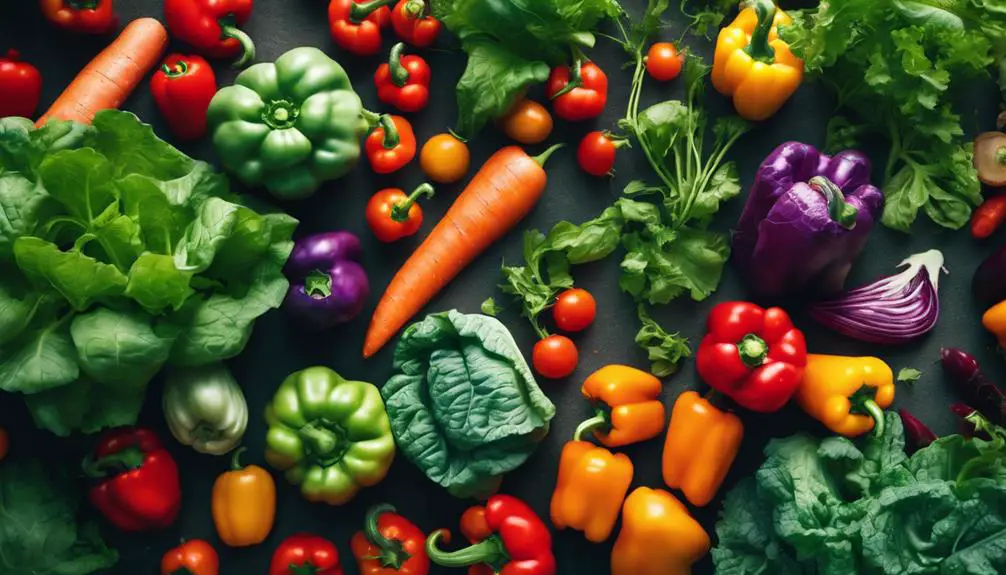
When designing your vegetable garden, you'll need to select the perfect vegetables that meet your personal taste preferences and growing conditions.
You'll want to weigh factors like climate, soil type, and available space when choosing the ideal crop varieties for your garden.
Vegetable Preferences Matter
Selecting the perfect vegetables for your garden begins with identifying your personal taste preferences and dietary needs, as this will influence the type and variety of vegetables you choose to grow.
Consider what you enjoy eating and what's lacking in your current diet. Do you prioritize crunchy snacks or hearty stews? Are you looking to incorporate more vitamins and minerals into your meals?
Make a list of your top vegetable priorities based on your personal tastes and nutritional needs.
Visualize your ideal garden, taking into account the space and climate you're working with. Think about the colors, textures, and growth habits of different vegetables.
Do you want a rainbow of bell peppers or a sea of emerald green broccoli? Consider the maturity rates and growth seasons of your chosen vegetables to guarantee a diverse and thriving harvest.
Choosing Crop Variety
By considering factors such as disease resistance, growth habits, and flavor profiles, you can narrow down the vast array of vegetable crop varieties to find the perfect ones for your garden.
When selecting crops, prioritize disease resistance to minimize maintenance and guarantee a bountiful harvest. Growth habits, such as vining or compact varieties, should also be considered to optimize space usage and accessibility.
Flavor profiles are equally important, as they can greatly impact the overall culinary experience. For instance, sweet and crunchy carrots can add a delightful texture to salads, while tangy and aromatic tomatoes can elevate pasta dishes.
To achieve crop diversity, incorporate a mix of cool-season and warm-season crops to secure a continuous harvest throughout the year.
Consider companion planting, where complementary vegetables are paired to enhance growth and reduce pests. For example, planting marigolds with tomatoes can deter nematodes and attract beneficial insects.
Designing for Efficient Watering
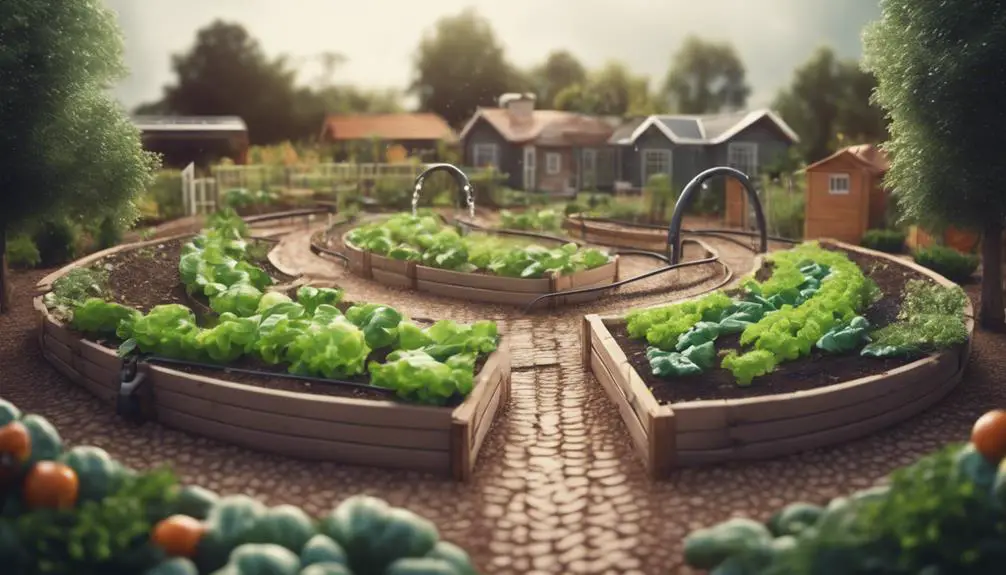
How do you guarantee your vegetable garden gets the right amount of water, exactly where it's needed, without wasting this precious resource?
Efficient watering is vital in vegetable garden design, and it starts with water harvesting. You can collect rainwater in tanks or barrels and use it to supplement your irrigation system. This reduces your reliance on municipal water and decreases your water bill.
When designing your irrigation system, consider using drip irrigation. This method delivers water directly to the roots of the plants, reducing evaporation and runoff. You can customize the system to fit your garden's specific needs, ensuring each plant receives the right amount of water.
By using emitters with different flow rates, you can cater to the varying water requirements of different crops.
Visualize your garden as a series of zones, each with its own watering needs. Divide your garden into sections based on factors like soil type, sunlight, and crop requirements.
This will help you create a tailored watering schedule that meets the unique needs of each zone. With water harvesting and drip irrigation, you'll be able to optimize water distribution and minimize waste, ensuring your vegetable garden thrives while conserving this valuable resource.
Companion Planting Strategies

When designing your vegetable garden, you'll want to ponder the complex relationships between different plants, as some will thrive together while others will struggle.
By strategically placing compatible vegetables, herbs, and flowers alongside each other, you'll create a harmonious and productive garden ecosystem.
As you plan your garden, think about how to pair plants that will benefit from each other's growth, such as planting marigolds with tomatoes to deter nematodes.
Plant Friends and Foes
You'll notice that certain vegetables thrive when paired with specific companions, a phenomenon rooted in the unique ways they interact with their surroundings and each other.
This harmonious relationship is known as companion planting, where Vegetable Allies work together to enhance growth, flavor, and pest resistance.
For instance, planting marigolds alongside tomatoes can deter nematodes, microscopic worms that attack tomato roots.
On the other hand, Garden Enemies can hinder growth or even spread disease.
Take, for example, the notorious duo of potatoes and tomatoes, which can transmit late blight to each other.
When designing your vegetable garden, it's crucial to weigh these interactions.
By strategically placing Vegetable Allies together, you can create a resilient and thriving ecosystem.
Conversely, separating Garden Enemies can prevent the spread of disease and pests.
By understanding these relationships, you can optimize your garden's layout to promote healthy growth and minimize potential risks.
Benefit From Neighbors
By harnessing the power of companion planting, you can create a harmonious neighborhood in your vegetable garden, where carefully chosen neighbors work together to boost growth, flavor, and pest resistance.
This clever approach allows you to tap into the unique strengths of each plant, fostering a community that's greater than the sum of its parts.
For instance, planting marigolds alongside tomatoes can deter nematodes, while basil and mint can enhance the flavor and aroma of nearby vegetables.
By strategically placing allies and repellents, you can create a balanced ecosystem that's resilient to pests and diseases.
To reap the benefits of companion planting, consider conducting community outreach by researching the specific needs and preferences of each plant.
Seek neighborly advice from experienced gardeners, and experiment with different pairings to find what works best for your unique climate and soil conditions.
Creating a Crop Rotation Plan
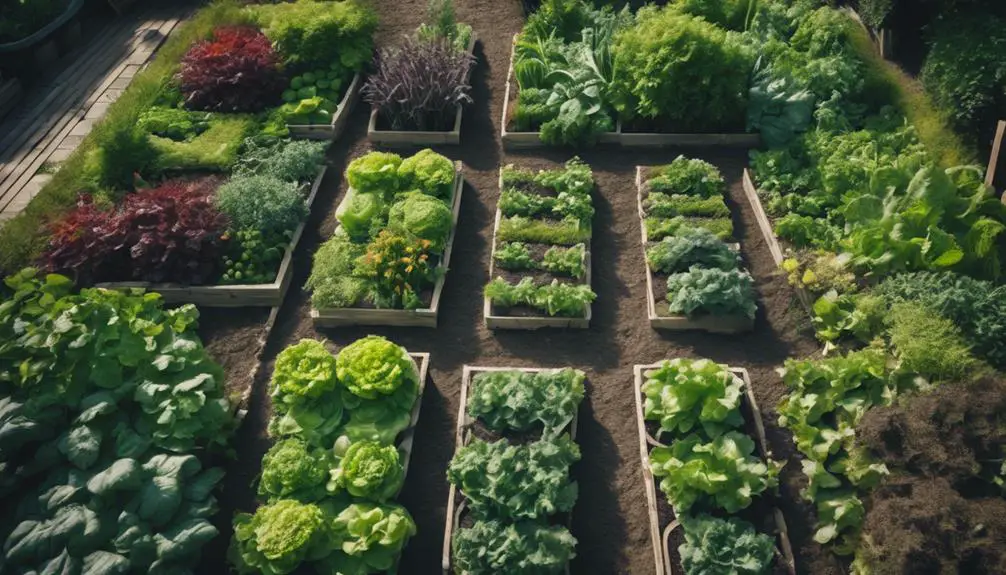
To guarantee prime soil health and minimize pest and disease buildup, create a crop rotation plan that takes into account the specific needs of each vegetable type.
This plan certifies that vegetables with similar requirements are grouped together, making it easier to manage soil conditions, sunlight, and water distribution.
Start by mapping your garden beds, dividing them into sections based on the vegetables you want to grow.
Next, group your vegetables into families, such as Brassicas (broccoli, cauliflower), Solanaceae (tomatoes, peppers), and Legumes (beans, peas).
This will help you rotate crops effectively, breaking disease and pest cycles.
Consider seasonal planning when creating your rotation plan.
For example, plant cool-season crops like kale and carrots in the spring, followed by warm-season crops like tomatoes and eggplants in the summer.
By rotating your crops, you'll maintain a balanced ecosystem, reducing the need for pesticides and fertilizers.
With a well-planned crop rotation, you'll enjoy a thriving and diverse vegetable garden.
Building Raised Garden Beds

When building raised garden beds, you'll need to decide on the materials for the frame, considering factors like durability, cost, and aesthetics.
The height of your garden bed is also vital, as it affects soil depth, accessibility, and drainage.
Bed Frame Materials
You can construct raised garden beds using a variety of bed frame materials, each offering unique benefits, durability, and aesthetic appeal.
Wood options, for instance, provide a natural, rustic look and can be sourced from sustainable forests. Cedar and redwood are popular choices due to their resistance to rot and insect damage. You can also use reclaimed or recycled wood to add a touch of nostalgia to your garden.
On the other hand, metal frames offer a modern, sleek design and can be made from durable materials like aluminum or steel. They're ideal for creating clean-lined, geometric shapes and can be powder-coated for added durability. When choosing metal frames, consider the gauge thickness and rust-resistance to guarantee they withstand the elements.
Both wood and metal frames can be combined with other materials, such as composite or recycled plastic, to create a unique look. Whichever material you choose, make sure it's durable, low-maintenance, and complements your garden's overall style.
Garden Bed Height
Raised garden beds can be built to varying heights, typically ranging from 3-6 inches for shallow-rooted plants to 12-18 inches or more for deeper-rooted vegetables and flowers, depending on the specific growing requirements of your chosen crops.
When deciding on the ideal height for your garden bed, consider factors such as garden accessibility and bed ergonomics. A raised bed with a higher wall can provide better accessibility for gardeners with mobility issues, allowing them to tend to their plants without straining their backs.
On the other hand, a lower bed can be more suitable for younger gardeners or those who prefer to work closer to the ground. You'll also want to think about the ergonomic benefits of a raised bed, such as reducing bending and kneeling.
Incorporating Vertical Gardening

By training vining vegetables like peas, cucumbers, and tomatoes to climb up trellises or arbors, you can maximize space and add visual interest to your garden.
This vertical gardening technique not only saves room but also creates a stunning display of foliage and blooms.
To incorporate vertical gardening, consider installing trellis systems or wall planters that provide support for your climbing vegetables.
Wall planters, for instance, can be attached to a fence or a wall, allowing you to grow vining vegetables like peas or cucumbers in a compact space.
Trellis systems, on the other hand, can be freestanding or attached to a wall, providing a framework for your vegetables to climb.
When choosing a trellis system, select one that's sturdy enough to support the weight of your vegetables and can withstand wind and weather conditions.
Adding Paths and Access Routes
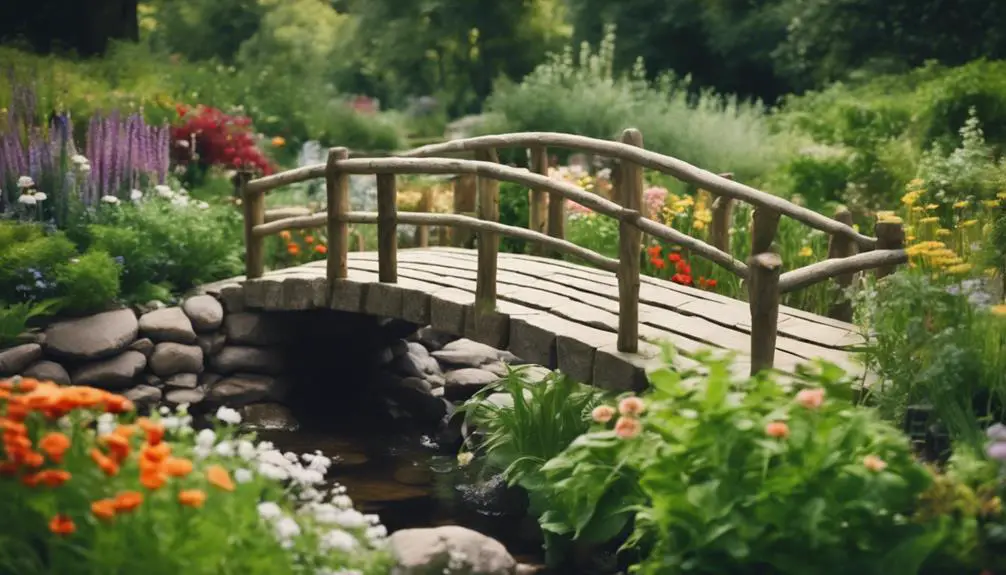
How do meandering paths and deliberate access routes influence the functionality and aesthetic of your vegetable garden design?
By incorporating thoughtful path design, you're creating an inviting space that guides visitors through your edible oasis. Meandering paths encourage exploration, while deliberate access routes facilitate easy maintenance and harvesting.
When selecting path materials, consider durability, drainage, and aesthetics. Gravel, wood chips, or brick pavers are popular choices, each offering unique benefits.
Gravel allows for excellent drainage, while wood chips add a natural, rustic touch. Brick pavers provide a clean, modern look.
Access width is also vital. A minimum of 2-3 feet is recommended to accommodate comfortable passage and easy access to beds.
Wider paths can accommodate wheelbarrows or carts, making maintenance a breeze. Narrower paths, around 1-2 feet, can create a sense of intimacy and make the garden feel more expansive.
Using Mulch and Cover Crops
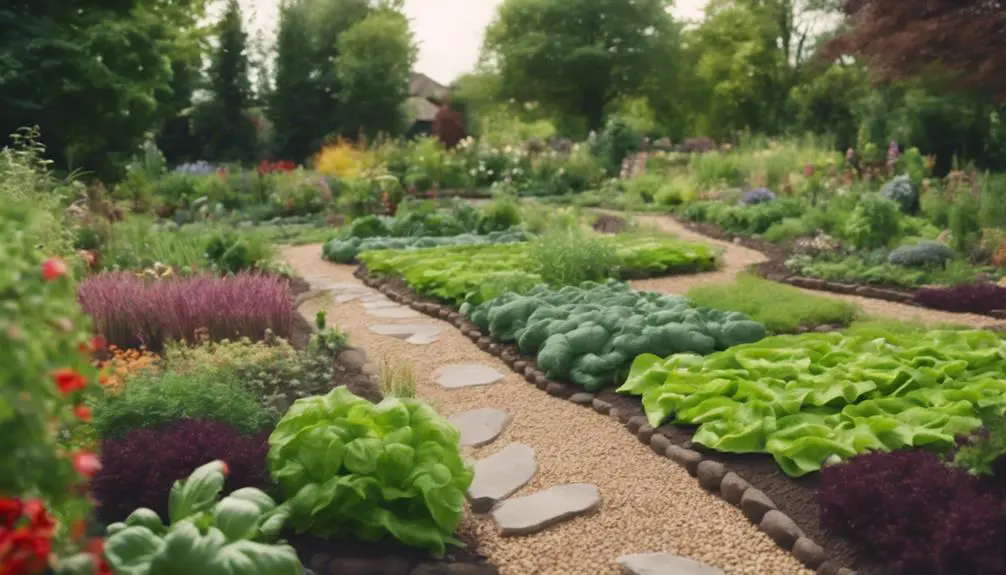
Two to three inches of organic mulch or a layer of cover crops can transform your vegetable garden, suppressing weeds, regulating soil temperature, and retaining moisture.
As you design your garden, consider the mulch benefits that will enhance your soil's health and structure. Organic mulch, such as straw or wood chips, breaks down over time, adding nutrients to the soil. It also prevents soil erosion and reduces the need for frequent watering.
On the other hand, cover crops like legumes or grasses can be planted in between crop cycles, adding nutrients and organic matter to the soil. Implementing a cover crop rotation will improve soil fertility, reduce erosion, and attract beneficial insects.
When choosing a mulch or cover crop, consider your garden's specific needs and climate. For example, if you live in a hot and dry region, opt for a mulch that retains moisture, such as straw or bark chips.
Controlling Pests and Diseases

In a thriving vegetable garden, pests and diseases can quickly turn a bountiful harvest into a disappointing loss, making it essential to incorporate control methods into your design.
As you plan your garden, consider the importance of natural pest control methods. You can introduce natural predators, such as ladybugs or lacewings, to prey on common pests like aphids and whiteflies.
Another approach is to use pest repellents, like neem oil or garlic spray, to deter pests from feeding on your crops.
When designing your garden, think about the layout and plant selection.
Some plants, like marigolds and basil, have natural pest-repelling properties and can be used as companion plants to protect your vegetables.
You can also use physical barriers, like fine-mesh row covers, to prevent pests from reaching your plants.
Additionally, maintain good garden hygiene by removing weeds, debris, and infected plants to prevent the spread of disease.
Frequently Asked Questions
How Often Should I Water My Vegetable Garden During Hot Summer Months?
During hot summer months, you'll want to water when the top 2-3 inches of soil feel dry to the touch, usually every 2-3 days, to maintain ideal soil moisture, ensuring your veggies receive the right amount of hydration without waterlogging.
Can I Grow Vegetables in Containers on a Balcony or Patio?
You can elevate your balcony decor or patio style by growing veggies in containers, using compact varieties and space-saving designs, and incorporating trellises or vertical planters to maximize space and visual appeal.
What Is the Purpose of Deadheading in a Vegetable Garden?
When you deadhead, you're not just removing wilted blooms; you're encouraging flower production, directing the plant's energy towards fruiting, and even aiding pest control by eliminating hiding spots for unwanted critters.
How Do I Prevent Vegetables From Becoming Too Large or Leggy?
To prevent veggies from becoming too large or leggy, you'll want to employ stem pruning techniques and implement support systems, like trellises or cages, to train plants to grow upright and promote bushy, compact growth.
Can I Grow Vegetables in the Shade if I Don't Have Sunny Spots?
If you don't have sunny spots, you can still grow veggies in shade. Look for shade-tolerant varieties like lettuce, spinach, and kale, and try partial shade planting techniques to maximize yields in low-light areas.
Conclusion
With your vegetable garden design in place, you're ready to reap the rewards of your planning.
Visualize the sun's rays illuminating your thoughtfully selected crops, and the efficient watering system nourishing their growth.
As you harvest your bounty, remember to rotate crops and maintain soil health to guarantee a thriving garden for seasons to come.
By incorporating vertical elements, paths, and mulch, you've created a visually appealing and productive space that's both a joy to work in and a tribute to your dedication.


